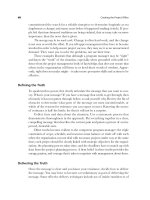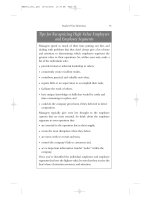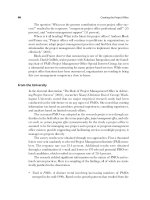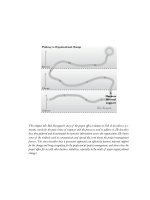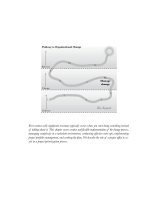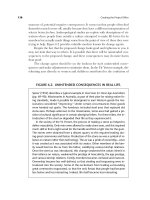Creating the project office 14
Bạn đang xem bản rút gọn của tài liệu. Xem và tải ngay bản đầy đủ của tài liệu tại đây (156.38 KB, 10 trang )
This chapter tells Bob Storeygard’s story of the project office evolution at 3M. It describes a sys-
tematic search for the pain (sense of urgency) and the processes used to address it. He describes
how they gathered and disseminated best practice information across the organization. He shares
some of the methods used to communicate and spread the word about the project management
process. The story describes how a grassroots approach can effectively harness internal support
for the change and bring recognition for the profession of project management, and shows how the
project office fits in with other business initiatives, especially in the midst of major organizational
changes.
1.
3.
4.
5.
Harness
internal
support
6.
7.
8.
9.
10.
11.
Refreeze
Change
Unfreeze
2.
Pathway to Organizational Change
109
CHAPTER FIVE
TELL THE TALE:
HARNESSING INTERNAL SUPPORT
Robert Storeygard, 3M
W
e hope by now you believe project management is a discipline that has
tremendous merit and bottom-line impact for organizations. You may have
even come to the conclusion that a project office or similar PM function may be a
good idea for your organization to embrace in order to shepherd and sustain the
introduction and practice of this discipline. But unless the function is tied to the
very lifeblood of the organization, it will be short-lived at best.
Finding Out Where It Hurts
How did Bob Storeygard tie the project office functions to the lifeblood of the or-
ganization at 3M? First of all, by knowing the starting point. As a number of areas
at 3M were beginning to put together efforts to launch project office initiatives,
they first collectively needed to address two questions:
• Do we have sufficient value to offer the organization in terms of project and
portfolio management skills and techniques that would merit establishment of
physical entities to deploy and sustain them?
• Is there enough identified and focused pain in the organization that people rec-
ognize the need for such help?
Y
If the answer was no to the first question, they were not ready to approach
the organization with the idea. Opening a project office prematurely can be dev-
astating. They needed to have their own act together first before marketing them-
selves and the project office concept to others.
If the answer to the first question was yes and the second question was no,
then their job changed, because the organization was not ready to hear what they
had to offer ...yet.They found they needed to intelligently bide their time and
help the organization get in touch with its own pain. To do this, they created some
initial “organizational pre-assessments” that would help organizations get con-
sensus on identifying where they currently were in terms of markets, competition,
internal issues, and skill sets. They approached this, of course, with a PM mind-set,
but they did not limit or significantly steer the pre-assessments toward PM solu-
tions to their issues. They let the chips fall where they might. Most organizations
were just grateful to have someone independently work with them to help them
clarify their own business situation. Sometimes it just takes someone with an out-
side business perspective to help a group see things more objectively and clearly.
Here are a few questions (and examples) that they used at 3M to guide orga-
nizations through the recognition process:
• What are the biggest or most aggravating business pains in your organization?
(Identification: products fail to commercialize, loss of customers.)
• Does your intuition tell you that these pains could be from PM-related sources?
(Relationships: lack of methodology, poor communications, or lack of stake-
holder management.)
• Are your conclusions just your opinion, or do others who have observed or ex-
perienced the pain share them? (Validation: the pain is only seen in this orga-
nization, it’s rampant across my area or in other areas.)
• Who else in the larger organization is experiencing similar pains? (Corrobora-
tion: another similar division experiencing same problems, industry groups
formed to deal with it.)
110 Creating the Project Office
Establish sense of
urgency— clear danger
• find where it hurts
• organize believers
• get the word out
• sustain the path
Leading
Organizational
Change
to PBO
Create guiding coalition—
powerful forces
Develop vision and
strategy—focus
Manage the change—
short-term wins, broad-based action,
consolidate gains
Develop broad-based action—
keep moving, implementing
Make change stick—
new PBO culture
The tale we tell
Communicate the change
vision—tell the tale
Staff and operate—
In or out?
If the answers to the two stem questions were both yes, then they realized that
they had passed the first major project office gauntlet and were ready to proceed.
But before moving on, they made sure to document their findings thoroughly from
the pre-assessment activity. That was an essential step because such findings, in
most cases, form the ideal basis for an initial offering of project office services to
be introduced later.
Much of this early pre-assessment work with organizations at 3M began with
concentrated efforts staffed through IT Education and Consulting groups. Similar
but more product-focused versions of this effort were also being done in the En-
gineering and Product Commercialization areas. These efforts extended not only
to IT-related groups domestically (within the United States) but also to interna-
tional operations in Latin America, the Pacific Rim, and Europe.
Although these individual efforts netted some early success in helping orga-
nizations identify their business pain and situations, they were not always coordi-
nated with or designed to enhance one another. Some of the key learnings and
value came from helping organizations examine their business issues as well as
their project and resource allocations and where that money was going. In some
cases it confirmed good methods and techniques already in place, and in others
it pointed up the lack of them.
These efforts helped various organizations within 3M identify their strengths
and weaknesses, their position in their marketplaces, and suggested how the judi-
cious application of project and portfolio management techniques might further
their efforts.
So now the change agents knew they had something of value to offer and that
the organization at large looked ripe to hear what they had to say and how they
proposed to help. The next major question they addressed was, “What do we do
about it?”
Early Attempts at Pain Relief
They realized that it would be premature to go straight for the implementation of
a formal project office. A full-blown office is rarely the first or the wisest step to
take in providing immediate relief to the organization. Using semimilitary par-
lance, they needed some preliminary efforts:
• Triage: Identify the more needy situations and help stem the bleeding (get some
basic charters, plans, and communication mechanisms in place).
• Stealth Missions: Dive into serious pain situations (with permission, of course) and
remove—in some cases, bomb—the pain to get it out of the way quickly and
efficiently (get a sponsor in place for a project, remove a troublesome or non-
functioning team member, help retain a customer through communication).
Tell the Tale 111
• Reindoctrination: Reeducation is sometimes needed to help people understand
how to operate in a new environment where project management can be a
major weapon. (Caution—beware the “sheep-dip approach” to training. That
is, don’t try to put everybody in the organization through the same training at
the same time, regardless of whether they are ready to apply it or not.) As
Storeygard notes, “effective training still needs to be done in the context of real
work and done in a timely fashion.”
Beyond these first steps, they needed to begin to build momentum at 3M toward
change by finding other victims of similar business pain, commiserating with them,
and beginning to provide opportunity for them to gather, share frustrations, vent,
and eventually exchange best practices and ways to deal with the pain. At 3M, this
began in the late 1980s with the formation of the Project Management Special In-
terest Group (PMSIG). This is a group that began with a half-dozen “believers”
from various disciplines across the company, and today stands at over three thou-
sand managers, project leaders, and team members in 3M worldwide.
The original organizing members of the PMSIG, convinced of the power of
PM and possessed of a passion for the discipline (vitally important), began iden-
tifying and coalescing project leaders, managers, and others tasked with various
forms of project leadership throughout 3M. They came together at first in a loose-
knit confederation, but soon they gathered executive sponsorship and formed the
PMSIG Steering Committee, which guided a number of years of unprecedented
growth through means such as monthly presentations, a well-done but short
newsletter, and a series of mini-conferences. Their executive sponsorship group
and the PMSIG Steering Committee were the “guiding coalition” (discussed in
Chapter Three) for many years and became the PM champions that were and are
the vanguard of 3M’s PM deployment efforts today. Storeygard says, “An impor-
tant lesson learned was to seek these champions in various areas of the organiza-
tion so as to spread the message quicker and more efficiently.”
Concrete Second Steps to Deal with PM Pain
These early attempts at pain relief began to focus the organization to allow them
to take more definitive steps in moving the effort forward. Here are additional
steps taken to further build the foundation for eventual project offices:
1. Continued to document the business pain discovered, identified the sources,
and began to develop organizational and individual PM assessment tools based
on the pre-assessment questions. The results allowed them to immediately pro-
112 Creating the Project Office
